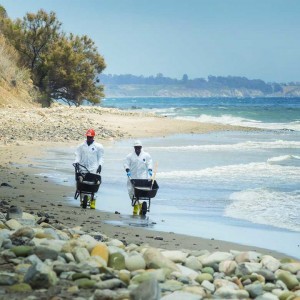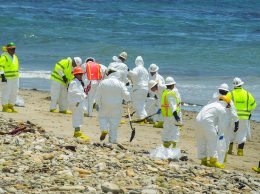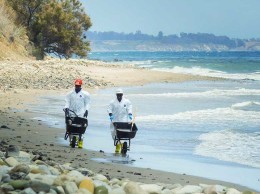Federal agency proposes tougher pipeline safety rules
IN THIS ARTICLE
- Energy Topic
- pacbiztimes Author
By pacbiztimes Friday, October 9th, 2015
The federal body governing pipeline safety has proposed new regulations that will change how oil and gas pipelines are operated, inspected and maintained.
Some of the rule proposals include requiring that all pipelines have a system for detecting leaks and establishing a timeline for pipeline inspections following a storm or natural disaster.
The Pipeline and Hazardous Materials Safety Administration would also require operators to annually evaluate the protective measures for pipelines in “high consequence areas” and improve the quality and frequency of maintenance tests as well as repairs.
Proposed regulations do not include a mandate for installing automatic shutoff valves. PHMSA intends to move forward with a separate rule concerning automatic valve usage in the near future, a PHMSA representative told the Business Times.
Current regulations follow the Pipeline Safety Act of 2011, which requires the automatic shutoff valves only in newly constructed or entirely replaced pipelines, PHMSA said.
Plains All American Pipeline’s Line 901 did not have an automatic shutoff valve, which could’ve limited some of the estimated 143,000 gallons of crude oil that soiled the Gaviota coastline when it ruptured on May 19.
The Houston-based company owns and operates the 10.6 mile line that runs parallel to Highway 101, which was worn down to 1/16th of an inch, PHMSA said. Line 901 lies within a “high consequence area,” PHMSA said.
Plains underestimated the spill’s size by more than 40,000 gallons in its initial “worst-case” projections.
Even though a Plains operator shut down the line at 11:30 a.m., it didn’t notify the National Response Corporation, a federal body that coordinates emergency responses, until 2:56 p.m.
Following the spill, Plains shut down both Line 901 and Line 903, which handcuffed oil companies like ExxonMobil and Venoco. Plains has not estimated when the pipelines will come back online.
The company declined to comment on how the proposed PHMSA rules would affect its operations.
Local officials and lawmakers have since urged better pipeline inspection regulations, a more coordinated emergency response protocol and improved pipeline technology.
“We believe that the devastating impacts of the Plains oil spill could have been avoided or greatly reduced had the pipeline been operated with up-to-date technology, such as automatic shutdown systems, and had it been inspected more frequently,” said Linda Krop, chief counsel of the Santa Barbara-based nonprofit Environmental Defense Center, in a letter on behalf of 28 environmental groups.
While the proposal is a step in the right direction, U.S. Rep. Lois Capps, D-Santa Barbara, said PHMSA has a long way to go.
“I remain frustrated by how long it has taken PHMSA to roll out these basic safety improvements and will continue working with my colleagues and PHMSA to ensure federal pipeline safety regulations are as strong as possible,” she said in a prepared statement.
Assemblymember Das Williams, D-Santa Barbara, authored AB 864 that requires pipelines in environmentally and ecologically sensitive areas along the coast to use the best technology, such as leak detection systems and automatic shutoff valves. But that would only impact pipelines in California, not ones that cross state lines, Williams said.
“My hope is that Plains All American will do the right thing and follow the stronger state standards in order to prevent another spill,” Williams said in an email to the Business Times.
Sen. Hannah-Beth Jackson, D-Santa Barbara, authored SB 295, which would require annual pipeline inspections by state regulators, and SB 414, which would allegedly make oil spill response faster and more effective.
Gov. Jerry Brown signed AB 864, SB 295 and SB 414 on Oct. 8.
Officials lamented the fact that Plains’ Line 903 is classified as an interstate pipeline, which means it has to abide by less stringent regulations than the state’s. Plains inspects its pipelines every three years even though the federal government only requires one every five years.
Plains’ inspection in 2012 didn’t raise enough alarm to trigger action. It did another inspection about two weeks before the spill but didn’t receive the results in time, the company said.
As of now, PHMSA only regulates gathering lines that meet certain size, location and operating pressure; some pipelines in rural areas fly under the radar. It governs less than 4,000 miles of the approximately 30,000 to 40,000 miles of onshore lines in the country, PHMSA said. The other 90 percent is not subject to any minimum federal standards.
The PHMSA proposal would extend reporting requirements to all gathering lines, including rural lines and ones that transport oil through gravity that are currently exempt.
The estimated annual cost of the improvements could run up to $16.7 million, PHMSA said, but they could prevent costly spills.
Plains CEO Greg Armstrong estimated the Refugio oil spill was a $257 million blunder, which factors in the emergency response and cleanup efforts as well as expected legal claims and potential settlements. It does not include any lost revenue from its pipeline shutdowns.
But the company would only shoulder $65 million of the $257 million because insurance would cover the rest, Armstrong said in an earnings report.
• Contact Alex Kacik at [email protected].













